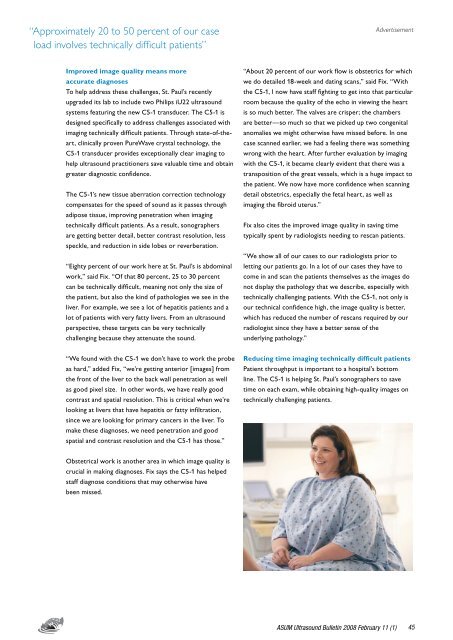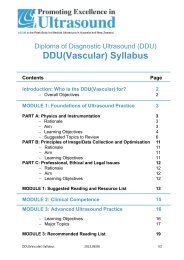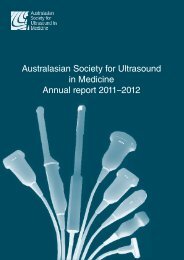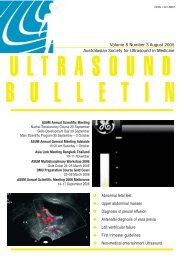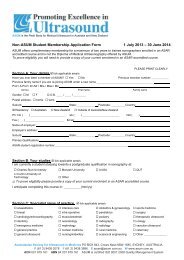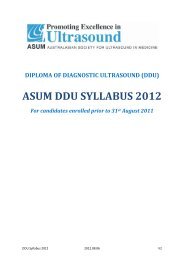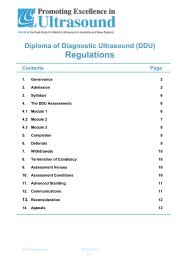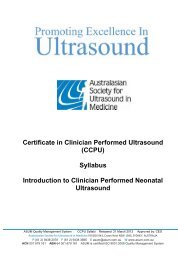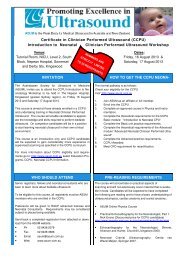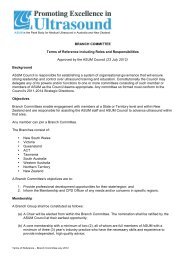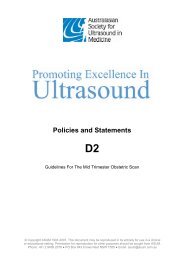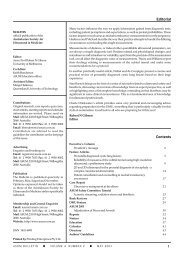Volume 11 Issue 1 (February) - Australasian Society for Ultrasound ...
Volume 11 Issue 1 (February) - Australasian Society for Ultrasound ...
Volume 11 Issue 1 (February) - Australasian Society for Ultrasound ...
You also want an ePaper? Increase the reach of your titles
YUMPU automatically turns print PDFs into web optimized ePapers that Google loves.
“Approximately 20 to 50 percent of our case<br />
load involves technically difficult patients”<br />
Advertisement<br />
Improved image quality means more<br />
accurate diagnoses<br />
To help address these challenges, St. Paul’s recently<br />
upgraded its lab to include two Philips iU22 ultrasound<br />
systems featuring the new C5-1 transducer. The C5-1 is<br />
designed specifically to address challenges associated with<br />
imaging technically difficult patients. Through state-of-theart,<br />
clinically proven PureWave crystal technology, the<br />
C5-1 transducer provides exceptionally clear imaging to<br />
help ultrasound practitioners save valuable time and obtain<br />
greater diagnostic confidence.<br />
The C5-1’s new tissue aberration correction technology<br />
compensates <strong>for</strong> the speed of sound as it passes through<br />
adipose tissue, improving penetration when imaging<br />
technically difficult patients. As a result, sonographers<br />
are getting better detail, better contrast resolution, less<br />
speckle, and reduction in side lobes or reverberation.<br />
“Eighty percent of our work here at St. Paul’s is abdominal<br />
work,” said Fix. “Of that 80 percent, 25 to 30 percent<br />
can be technically difficult, meaning not only the size of<br />
the patient, but also the kind of pathologies we see in the<br />
liver. For example, we see a lot of hepatitis patients and a<br />
lot of patients with very fatty livers. From an ultrasound<br />
perspective, these targets can be very technically<br />
challenging because they attenuate the sound.<br />
“About 20 percent of our work flow is obstetrics <strong>for</strong> which<br />
we do detailed 18-week and dating scans,” said Fix. “With<br />
the C5-1, I now have staff fighting to get into that particular<br />
room because the quality of the echo in viewing the heart<br />
is so much better. The valves are crisper; the chambers<br />
are better—so much so that we picked up two congenital<br />
anomalies we might otherwise have missed be<strong>for</strong>e. In one<br />
case scanned earlier, we had a feeling there was something<br />
wrong with the heart. After further evaluation by imaging<br />
with the C5-1, it became clearly evident that there was a<br />
transposition of the great vessels, which is a huge impact to<br />
the patient. We now have more confidence when scanning<br />
detail obstetrics, especially the fetal heart, as well as<br />
imaging the fibroid uterus.”<br />
Fix also cites the improved image quality in saving time<br />
typically spent by radiologists needing to rescan patients.<br />
“We show all of our cases to our radiologists prior to<br />
letting our patients go. In a lot of our cases they have to<br />
come in and scan the patients themselves as the images do<br />
not display the pathology that we describe, especially with<br />
technically challenging patients. With the C5-1, not only is<br />
our technical confidence high, the image quality is better,<br />
which has reduced the number of rescans required by our<br />
radiologist since they have a better sense of the<br />
underlying pathology.”<br />
“We found with the C5-1 we don’t have to work the probe<br />
as hard,” added Fix, “we’re getting anterior [images] from<br />
the front of the liver to the back wall penetration as well<br />
as good pixel size. In other words, we have really good<br />
contrast and spatial resolution. This is critical when we’re<br />
looking at livers that have hepatitis or fatty infiltration,<br />
since we are looking <strong>for</strong> primary cancers in the liver. To<br />
make these diagnoses, we need penetration and good<br />
spatial and contrast resolution and the C5-1 has those.”<br />
Reducing time imaging technically difficult patients<br />
Patient throughput is important to a hospital’s bottom<br />
line. The C5-1 is helping St. Paul’s sonographers to save<br />
time on each exam, while obtaining high-quality images on<br />
technically challenging patients.<br />
Obstetrical work is another area in which image quality is<br />
crucial in making diagnoses. Fix says the C5-1 has helped<br />
staff diagnose conditions that may otherwise have<br />
been missed.<br />
ASUM <strong>Ultrasound</strong> Bulletin 2008 <strong>February</strong> <strong>11</strong> (1)<br />
45


